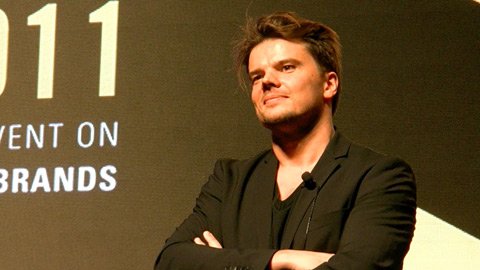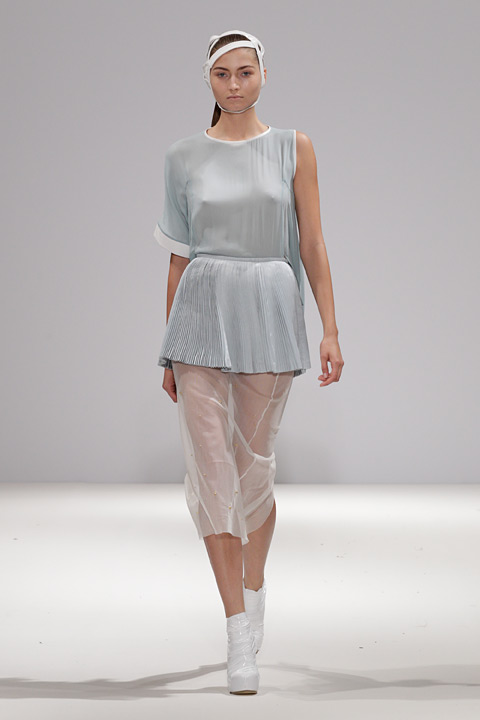This year brought the 9th edition of BODW Business of Design Week to Hong Kong. The program ran from November 28 to December 3, and is Asia's leading annual event on design, innovation and brands. Over the course of the three-day conference, alongside hundreds of other visitors we were able to witness first-hand a free flowing exchange of ideas facilitated by numerous exhibitions and seminars.
"Architects need to find ways to present their ideas or concerns in words that are so clear that non-architects will actually take an interest in them," said Bjarke Ingels, founding partner of the Bjarke Ingels Group, the Copenhagen-based architecture firm. He takes his message to the people: in a speech titled "Hedonistic Sustainability, Social Infrastructure and Public Participation Extreme," Ingels delivered a motivational talk about how to make sustainable buildings fun. In the "public participation" part of his talk, Ingels spoke about the city hall his firm designed for Tallinn, Estonia. Its main chamber has a mirrored and angled ceiling that functions as a "democratic periscope" to reflect the meetings of civic leaders to the public in a central plaza outside. The reflected images offer a "perfect overview of the city council, so you can see which people are absent, or sleeping, or doing dirty deals," Ingels said, to loud laughter. Bjarke Ingels is already playing a strong part in helping shape contemporary architecture in China. His proposal for the Shanghai "Ren" People's Building and his Shenzhen Energy Mansion, currently being built, ensured Ingels had a presence and substantial following in Asia well before his lecture.
Japanese architect Shigeru Ban drew on the two main activities of his planning office: research into adapting materials in an unconventional museum building and designing emergency housing. Ban is feted by the critics for his innovative approaches to environmentally sound architecture as well as for his dedication to humanitarian efforts in the wake of some of the most devastating natural and manmade disasters of the past two decades.
Both architects value interaction and participation by the inhabitants and general public when it comes to architectural spaces, and both promote an approach to architecture that is at once playful and realistic. Each presents in their respective work some of the first specimens of a new species of architecture, combining functional and energy-efficient working and living spaces with a socially responsible and more sustainable setting.
The unparalleled line-up of international participants at BODW included: famed Italian architects and designers Antonio Citterio and Piero Lissoni; Taiwanese designers Wu Ching-Yu of Eslite and Jeff Shi of Dragonfly; Japanese-American graphic designer, computer scientist and president of the RISD design college John Maeda; and UK's Spencer de Grey of Foster and Partners Architects.
For the Chinese participants, increased urban density has become associated with a new sense of identity. China is one the fastest growing economies in the world – and the Chinese design world is likewise expanding fast. China has so much to offer – from traditional classic Chinese influences, to modern day, contemporary pieces – and Chinese design is truly on the crest of a wave. Among some of the most successful and influential Chinese designers are Jiang Qiong Er (founder of fashion brand Shang Xia of Hermes), Freeman Lau (co-founder of Kan & Lau), interior designer Steve Leung, fashion designer Masha Ma; and artist Shao Fan. They discussed the difficulties and opportunities inherent in navigating the bounds of heritage and innovation.
For 2011, the BODW partner nation was Germany. German affiliates attended the conference for a global discussion of trends and recent contributions in technology and the relationship between the worlds of design and business. The country's "Brand New Germany" campaign reflects its numerous recent creative accomplishments. BODW, organized by the Hong Kong Design Centre, fielded an excellent array of speakers representing the various design fields who commented on contemporary developments and issues within their scope. Dieter Rams, former Head of Design at Braun, kicked off the week's debate on the notion of "Germany in Design", referring to the innovative contribution Germany has made to the international design scene.
The intrinsic connection between brands and design was reflected on in a forum that brought together German Markus Miele, great-grandson of the founder of the home appliances company Miele, Roland Heiler, Managing Director of Porsche Design Studio, and Oliver Holy, CEO of Classicon. Miele, Heiler and Holy all emphasized the connection between the collective consciousness and the psychology of the public in forming a sense of value for a brand through design. Joachim Sauter, founder and Creative Director of Art+Com, architect Werner Sobek and Annemarie Jaeggi, Director of Bauhaus Archive Museum of Design brought to the discussion an awareness for the scientific and methodological procesess present in today's visual communication. Construction design as a highly influential force within the structure and culture of a city was explored through the eyes of architects Ole Scheeren, Jürgen Mayer H and Louisa Hutton, who pondered the notion of concept and detail quality in project completion.
Germany is particularly known in Asia for its automotive design and for the production of luxury cars. Stefan Sielaff, Head of Audi Design, discussed the introduction of aluminum into car interior composition and the reflective aesthetic in both the interior and exterior. Adrian Van Hooydonk, BMW's Senior Vice President of Group Design, elaborated on concept cars and vehicles already beign rolled out. While French designer Olivier Boulay, the Vice President of the Mercedes-Benz Advanced Design Center of China in Beijing, focused on the connection between Asian and German car designs and industry.
The field of fashion label branding was introduced by Alessandro Cremonesi, Chief Executive Director of Jil Sander Group, and Gerrit Rützel, CEO Asia Pacific of Hugo Boss. They both deliberated on the power of design in the business of fashion brand management. Industrial designer and "material craftsman" Stefan Diez and Manfred Dorm, the Managing Director of Phoenix Design brought an appreciation for experimentation in product development to bear in the discussions.
Birgit Lohmann is founder and editor-in-chief of designboom, a Milan-based blog about design culture, architecture, art, photography and graphics.
 Hong Kong as venue of the BDOW, photo © Lichunngai
Hong Kong as venue of the BDOW, photo © Lichunngai
 Shigeru Ban as one of the main speakers, photo © Designboom
Shigeru Ban as one of the main speakers, photo © Designboom
 The talks were received with high interest, photo © Designboom
The talks were received with high interest, photo © Designboom
 Dieter Rams, photo © Designboom
Dieter Rams, photo © Designboom
 Bjarke Ingels, photo © Designboom
Bjarke Ingels, photo © Designboom
 Ole Scheeren, photo © Designboom
Ole Scheeren, photo © Designboom
 Piero Lissoni, photo © Designboom
Piero Lissoni, photo © Designboom
 Stefan Diez, photo © Designboom
Stefan Diez, photo © Designboom
 Jürgen Mayer H. (in the middle) in front of the „German Design Loft”, photo © Designboom
Jürgen Mayer H. (in the middle) in front of the „German Design Loft”, photo © Designboom
 “Da Tian Di“ chair inspired by furniture by the Ming dynasty, photo © Shang-Xia
“Da Tian Di“ chair inspired by furniture by the Ming dynasty, photo © Shang-Xia
 “Garden Jewellery”, photo © Shang-Xia
“Garden Jewellery”, photo © Shang-Xia
 Arm-chair “Ling Long” by Steve Leung, photo © Steve Leung
Arm-chair “Ling Long” by Steve Leung, photo © Steve Leung
 Reception at the W Hotel Hongkong designed by Steve Leung, photo © Steve Leung
Reception at the W Hotel Hongkong designed by Steve Leung, photo © Steve Leung
 “German Design Loft” at the BDOW, curated by Jürgen Mayer H., photo © German Design Council
“German Design Loft” at the BDOW, curated by Jürgen Mayer H., photo © German Design Council
 Germany represented as the partner nation of this year, photo © German Design Council
Germany represented as the partner nation of this year, photo © German Design Council
 Motto “Brand New Germany“, photo © German Design Council
Motto “Brand New Germany“, photo © German Design Council
 Jürgen Mayer H., photo © German Design Council
Jürgen Mayer H., photo © German Design Council
 Young audience on chairs by Plank, photo © German Design Council
Young audience on chairs by Plank, photo © German Design Council
 Fashion from China by Masha Ma, photo © Masha Ma
Fashion from China by Masha Ma, photo © Masha Ma
 Dress from the summer collection 2012 by Masha Ma, photo © Masha Ma
Dress from the summer collection 2012 by Masha Ma, photo © Masha Ma
 “Sculpture“ out of cashmere felt by Shang-Xia, photo © Shang-Xia
“Sculpture“ out of cashmere felt by Shang-Xia, photo © Shang-Xia
 “Fuqi“, photo © Shang-Xia
“Fuqi“, photo © Shang-Xia
 Jewellery in the form of a water-pot, photo © Shang-Xia
Jewellery in the form of a water-pot, photo © Shang-Xia
 “Gongfu Tea Table“, photo © Shang-Xia
“Gongfu Tea Table“, photo © Shang-Xia
 “Echo”, photo © Shang-Xia
“Echo”, photo © Shang-Xia
 Furniture-collection “Techni” by Steve Leung, photo © Steve Leung
Furniture-collection “Techni” by Steve Leung, photo © Steve Leung
 Xiao Nan Guo Restaurant, interior-design by Steve Leung, photo © Steve Leung
Xiao Nan Guo Restaurant, interior-design by Steve Leung, photo © Steve Leung
